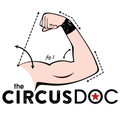What is common is not normal.
Have you ever worked with anyone that trains a circus discipline, literally any kind of discipline from juggling to hand balancing, from teeterboard to trapeze? If so, you have probably seen someone with an injury or nagging condition or, of course, pain. Well, what are these common injuries? What should we be looking for, or even expecting, when a circus artist comes to your clinic for treatment? AND, how can you help prevent these common circus injuries?
First, let’s discuss the circus environment. It is a place where artists are instructed, sometimes even rewarded, for “soldiering on”. Artists of all levels often continue to perform and train through injuries either due to internal factors (a love of training or feeling of responsibility), finances (for professional performers), external pressures (from coaches, peers, or directors), or circus cultural norms. A professional artist might push through because of a short-term gig where they just need to make it to “the end of the run”. Or, maybe a fellow artist is telling the them that their pain is normal for or training. While I might agree that there are some bruises or the occasional post training soreness that is usually benign and expected, dare I say “normal”—there are far more signs and symptoms that should not be minimized….
Yes, circus hurts, but when that mindset keeps an artist training it may often exacerbate the underlying problem, or delay recovery. A longer term injury can create compensations throughout the aritist’s body which increases the likelihood of a slower recovery overall of another body part getting injured.
As circus clinicians our job is to educate artists about when to seek care. Not all recreational artists come from a sports/movement background and may need to know the difference between soreness, injury, and pain. If they do have an injury, then it is the education that seeking care as soon as possible, (yes, as soon as they feel that “something is off”) will allow them to recover more quickly. Seeking care does not mean the artist cannot train or perform! Getting evaluated should enhance their overall performance levels, including training and performing in shows and gigs.
For professional artists, their bodies are their livelihood and their instrument and many will do a lot to avoid admitting to themselves or others that they are injured (in the circus realm this is their version of fear avoidance behaviors). Artists will start modifying their training, their performance, and/or their conditioning, eliminating various positions or elements that they assume will cause pain or flare them up more. Some artists are worried that their pain is never going to go away or may be career ending. Those fears may stop them from reaching out for care especially if they think the clinician is going to tell them to stop training.
Too many artists assume circus = pain. Anything we can do to reverse this myth is culture changing! Yes, there might be some normal wear and tear, but there are still plenty of interventions and tools to use to prevent the artist from exacerbating a chronic injury or even minimizing the “It’s ok.. I’m just going to avoid XYZ in training today” (again…) Avoiding painful movements is fine—but, not doing anything to resolve the underlying injury/condition or only finding advice from peers or the internet…? That’s where we can come in with education, advice, and skilled care to help the artist get back to their training at full capacity (or even better). So instead of artists avoiding training and wondering why nothing improves, we can help artists continue to train and perform as they solve the route cause of their injuries or pain.
1. Bolling C, Mellette J, Pasman HR, van Mechelen W, Verhagen E. From the safety net to the injury prevention web: applying systems thinking to unravel injury prevention challenges and opportunities in Cirque du Soleil. BMJ Open Sport Exerc Med. 2019;5(1):e000492. doi:10.1136/bmjsem-2018-000492
2. Cayrol T, Godfrey E, Draper-Rodi J, Bearne L. Exploring Professional Circus Artists’ Experience of Performance-Related Injury and Management: A Qualitative Study. Med Probl Perform Art. Mar 2019;34(1):14-24. doi:10.21091/mppa.2019.1004
